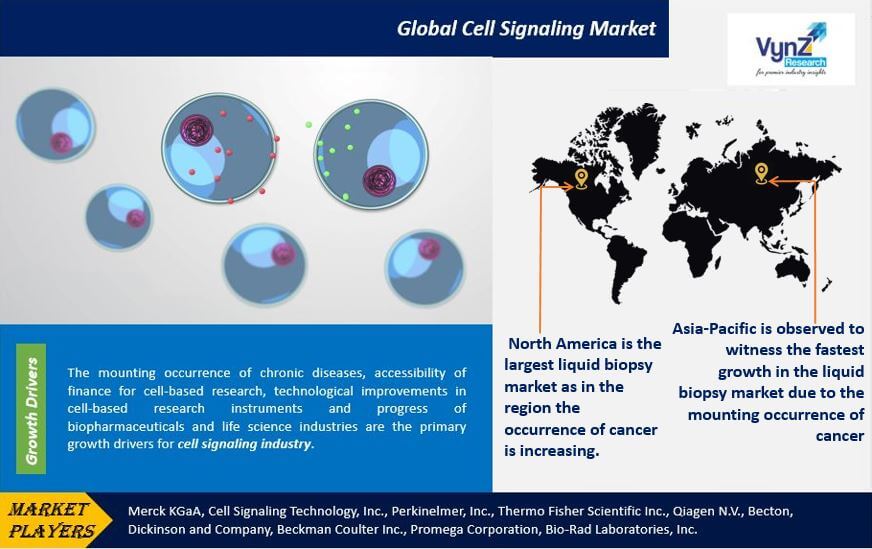| Status : Upcoming | Report Code : VRHC1034 | Industry : Healthcare | Available Format :

|

Global Cell Signaling Market – Analysis and Forecast (2025-2030)
Industry Insights by Product (Consumables and Instruments), by Technology (ELISA, Microscopy, Western Blotting, Mass Spectrometry, Immunohistochemistry, Flow Cytometry and Others) by Signaling Type (Juxtacrine, Endocrine, Autocrine, Paracrine and Others) by Pathway (JAK/STAT, AKT, Hedgehog, AMPK, Notch, ErbB /HER, NF-KB and Others) and by Application (Research and Medical)
Industry Overview
The global cell signaling market is expected to grow from USD 5.41 billion in 2023 to USD 8.94 billion by 2030 at a compound annual growth rate (CAGR) of 7.56% during the forecast period ranging from 2025 to 2030.
Cell signaling is complicated interactive system that controls and intermediates numerous cellular reactions in the human body. These signaling pathways chiefly comprise interactive proteins that can progress to particular locations. It enables the identification of specific signaling molecules and pathways that contribute to cancer progression. It is a reliable approach to treat such disorders. It also enables simultaneous acquisition of high-resolution bright-field images and robust fluorescent flow cytometry data from cells which enhances comprehensive analysis of cell characteristics. This helps the researchers to identify specific molecules and mechanisms related to the diseases, especially cancer and other disorders.

The global cell signaling market is growing at fast rate due to the growing incidence of chronic diseases and the rapid technological advancements in cell-based research instruments. Also, rising government funding for research to understand cell signaling pathways and their implications on health and disease propels the market growth.
The stringent regulatory standards and the high capital requirement preventing new entries to the market prevents market expansion. Growth opportunities are however offered by the strategic partnerships and collaborations between the major market players that promotes innovation and new product launch.
Market Segmentation
Insight by Product
The global cell signaling market is divided on the basis of products into consumables and instruments segments, where the consumables segment will witness a higher growth due to increasing occurrence of chronic diseases, higher research activities, repurchasing, advances in genomes and proteomics, higher emphasis on customized medicine and targeted therapies. This segment is further sub divided into reagents, antibodies, assay kits and others, where the antibodies subsegment will account for the largest share due to its higher applicability and adoption in mapping, disease detection, and structural analysis. The instruments segment will grow at a high CAGR over the forecast period due to technological advancements, growing demand for automated systems, higher demand for PoC diagnostics, rising prevalence of chronic diseases, and increased fund for cell-based research.
Insight by Signaling Type
The global cell signaling market is divided on the basis of signaling type into juxtracrine signaling, endocrine signaling, autocrine signaling, paracrine signaling and other segments. Out of them, the endocrine signaling segment will grow at a higher CAGR during the forecast period due to better communication and transfer of chemical signals, and increased prevalence of endocrine-related disorders in a number of patients.
Insight by Technology
The global cell signaling market is divided on the basis of technology into Elisa, microscopy, western blotting, mass spectrometry, immunohistochemistry, flow cytometry and other segments. Out of all these segments, the microscopy segment will witness a higher growth during the forecast period due to its higher application beyond localization, use of several methodologies, ability for real-time study for and investigation of single-cell expression kinetics, and technological breakthroughs. On the other hand, flow cytometry is also expected to grow at a high CAGR due to its high usefulness in studying the immune system and how it responds to infectious diseases and cancer.
Insight by Pathway
The global cell signaling market is divided on the basis of pathways into JAK/STAT signaling pathway, AKT signaling pathway, hedgehog signaling pathway, AMPK signaling pathway, notch signaling pathway, ErbB /HER signaling pathway, NF-KB signaling pathway and others. Out of these segments, the AKT signaling pathway will grow at a high rate due to higher adoption in elementary research and drug development and the projected development of commercial diagnostic tests depending on the down-regulation of the AKT pathway. The AMPK signaling pathway segment will also grow due to an increase in the prevalence of cancer and tumors worldwide.
Insight by Application
The global cell signaling market is also divided on the basis of applications into two major segments namely, medical and research. Out of these two segments, the research application segment is expected to grow at a significant rate and dominate the cell signaling market during the forecast period due to the growing applicability in cancer research.
Global Cell Signaling Market Report Coverage
|
Report Metric |
Details |
|
Historical Period |
2018 - 2023 |
|
Base Year Considered |
2024 |
|
Forecast Period |
2025 - 2030 |
|
Market Size in 2024 |
U.S.D. 5.41 Billion |
|
Revenue Forecast in 2030 |
U.S.D. 8.94 Billion |
|
Growth Rate |
7.56% |
|
Segments Covered in the Report |
By Product, By Signaling Type, By Technology, By Pathway and By Application |
|
Report Scope |
Market Trends, Drivers, and Restraints; Revenue Estimation and Forecast; Segmentation Analysis; Impact of COVID-19; Companies’ Strategic Developments; Market Share Analysis of Key Players; Company Profiling |
|
Regions Covered in the Report |
North America, Europe, Asia-Pacific, Middle East, South America and Rest of the World |
Industry Dynamics
Industry Trends
The key trends noticed in the cell signaling market include the strategies implemented by major players in this market to expand their product line with new launches, market expansions through strategic acquisitions and partnerships, and more. It is also noticed that there is a notable shift in the geographical distribution of cell signaling from developed countries to emerging economies due to their greater disease variation.
Growth Drivers
The major factors for the growth of the global cell signaling market are significant development of biopharmaceuticals and life science industries. It is also attributed to the rise in the geriatric population with chronic conditions. In addition, the growth of this market is propelled further by the significant development of microfluidics in cell biology research and the higher applicability of cell signaling in biotechnology. Furthermore, the developing life science infrastructure and further investment in R&D programs to enhance the efficacy of the technology is fueling the market growth. The higher adoption of advanced healthcare technologies also contributes significantly to the growth of the global dell signaling market.
Challenges
One of the most prominent factors that influences the growth of the cell signaling market is the high cost of the systems and the complexities related to reagent and antibody development. In addition, the significant socio-ethical issues involved in stem cell research such as religious beliefs and destruction of human embryo are considered to be hindering the market growth.
Opportunities
The expertise of the prominent market players, the growing investment in research and development, and rapid commercialization of products are presenting significant growth opportunities to the global cell signaling market.
Geographic Overview
North America holds the largest share of the cell signaling market due to rising number of chronic diseases. In addition, the rise in healthcare expenditure and the increased the accessibility and affordability of treatment among the individuals along with the growing geriatric population, large number of research institutes, and improved life science infrastructure are also propelling the market growth.
The Asia-Pacific market will grow due to the large population base, growing incidents of chronic diseases, higher investments in research and development activities, rising partnership of main players with local manufacturer, growing geriatric population, and improving life science infrastructure.
Competitive Insight
Key players in the cell signaling market are catering the demand of these devices by investing on technologically advanced products in their product portfolio across the globe. Cell Signaling Technology has commenced an office in Shanghai China, to encourage the swiftly multiplying China life science market. Merck KGaA, Cell Signaling Technology, Inc., Perkinelmer, Inc., Thermo Fisher Scientific Inc., Qiagen N.V., Becton, Dickinson and Company, Beckman Coulter Inc., Promega Corporation, Bio-Rad Laboratories, Inc., and Bio-Techne Corporation are the key players offering products.
Bio-Rad Laboratories, Inc. is an American developer and manufacturer of specialized technological products for the life science research and clinical diagnostics markets. Company detect signal transduction proteins with high specificity using bead-based multiplex immunoassays.
Beckman Coulter, Inc. is a Danaher Corporation company that develops, manufactures and markets products that simplify, automate and innovate upon complex biomedical testing. Beckman Coulter Diagnostics helps healthcare professionals provide better patient care by delivering the accurate diagnostic information they need.
Recent Developments by Key Players
Merck (a leading science and technology company) invested Euro 62 million at its Darmstadt for its Life Science business. The facility shall bring together several departments into one collaborative state-of-the-art space. The new building is part of an investment program at the Darmstadt site.
Bio-Rad Laboratories, Inc., a global leader in life science research and clinical diagnostic products, today announced the launch of the 29th StarBright Dye, StarBright Red 670, and an expansion of its current range with 29 additional highly validated antibodies conjugated to StarBright Blue 700 and StarBright Violet 610 Dyes. Including additional human and mouse targets and introducing dog, cow, and pig targets, the new range provides greater choice and flexibility in conventional and full-spectrum multicolor flow cytometry panels, expanding research capabilities across veterinary immunology research.
The Cell Signaling Market report offers a comprehensive market segmentation analysis along with an estimation for the forecast period 2025–2030.
Segments Covered in the Report
- By Product
- Consumables
- Instruments
- By Technology
- ELISA
- Microscopy
- Western Blotting
- Mass Spectrometry
- Immunohistochemistry
- Flow Cytometry
- Others
- By Signaling Type
- Juxtacrine
- Endocrine
- Autocrine
- Paracrine
- Others
- By Pathway
- JAK/STAT
- AKT
- Hedgehog
- AMPK
- Notch
- ErbB /HER
- NF-KB
- Others
- By Application
- Research
- Medical
Region Covered in the Report
- North America
- U.S.
- Canada
- Mexico
- Europe
- Germany
- U.K.
- France
- Italy
- Spain
- Russia
- Rest of Europe
- Asia-Pacific (APAC)
- China
- Japan
- India
- South Korea
- Rest of Asia-Pacific
- Rest of the World (RoW)
- Brazil
- Saudi Arabia
- South Africa
- U.A.E.
- Other Countries
.png)
Source: VynZ Research
.png)
Source: VynZ Research
Frequently Asked Questions
Purchase Options
Latest Report
Research Methodology
- Desk Research / Pilot Interviews
- Build Market Size Model
- Research and Analysis
- Final Deliverabvle
Connect With Our Sales Team
- Toll-Free: 1 888 253 3960
- Phone: +91 9960 288 381
- Email: enquiry@vynzresearch.com
Cell Signaling Market
